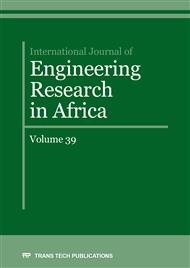[1]
L. Wang, & W. Shen. Process Planning and Scheduling for Distributed Manufacturing. Springer-Verlag London Limited, London, UK (2007).
Google Scholar
[2]
J. Seyed. Optimal production planning. OR/MS Today, (1996). 23(2),56-59.
Google Scholar
[3]
J. Seyed. Strenthening key links, OR/MS Today, (1998). 25(2),58-61.
Google Scholar
[4]
E. D. Gomez Urrutia. Integrated optimization of planning and scheduling decisions in a logistics chain. Saint Etienne: Doctoral thesis at the national higher school of mines. Specialty: Industrial Engineering (2014).
Google Scholar
[5]
C. Wolosewicz. Integrated Approach to Planning and Production Scheduling. Doctoral thesis at the national higher school of mines. Saint Etienne, Saint Etienne, France (2008, april 22).
Google Scholar
[6]
C. Maravelias, & C. Sung. Integration of production planning and scheduling: Overview, challenges and opportunities. Computers & Chemical Engineering (2009, December 12). Vol. 33(No. 12), p.1919-(1930).
DOI: 10.1016/j.compchemeng.2009.06.007
Google Scholar
[7]
A. Mehra, I. Minis, & J. Proth. Hierarchical production planning for complex manufacturing systems. Advances in Engineering Software (1996). Vol. 26, pp.209-218.
DOI: 10.1016/0965-9978(95)00117-4
Google Scholar
[8]
E. D. Gómez Urrutia, R. Aggoune, & S. Dauzère-Pérès. New integrated method to solve the problem of planning and scheduling. 13th Congress of the French Society for Operational Research and Decision Support - ROADEF. Apr, Angers. France (2012).
Google Scholar
[9]
Z. I. M. Hassani et al., Models for Solving Integrated Planning and Scheduling Problem: Computational Comparison,, International Journal of Engineering Research in Africa, Vol. 34, pp.161-170, (2018).
DOI: 10.4028/www.scientific.net/jera.34.161
Google Scholar
[10]
C. Wolosewicz. Integrated Approach to Planning and Production Scheduling. Doctoral thesis at the national higher school of mines. Saint Etienne, Saint Etienne, France (2008, april 22).
Google Scholar
[11]
C. Wolosewicz, S. Dauzère-pérès, & R. Aggoune. A new approach for solving integrated planning and scheduling problem. In INCOM2006 (2006).
DOI: 10.3182/20060517-3-fr-2903.00112
Google Scholar
[12]
S. Dauzère-Pérès, & J. Lasserre. Integration of lot sizing and scheduling decisions in a jobshop. European Journal of Operations Research, (1994). 413–426.
Google Scholar
[13]
C. Wolosewicz, S. Dauzère-Pérès, & R. Aggoune. A solving procedure for a general integrated lot sizing and fixed scheduling problem. European Journal of Operational Research (2012).
DOI: 10.1016/j.ejor.2015.01.034
Google Scholar
[14]
S. Dauzère-Pérès, & J. Lasserre. On the importance of sequencing decisions in production planning and scheduling. International Transactions in Operational Research, (2002). 779–793.
DOI: 10.1111/1475-3995.00388
Google Scholar
[15]
S. Dauzère-Pérès. Integrated approach to planning and scheduling production, Doctoral Thesis, Paul Sabatier University, Toulouse, France (1992).
Google Scholar
[16]
C., Wolosewicz, S. Dauzère-Pérès, R. Aggoune. A Lagrangian heuristic for an integrated lot-sizing and fixed scheduling problem,, European Journal of Operational Research, Elsevier, 244 (1), pp.3-12. (2015).
DOI: 10.1016/j.ejor.2015.01.034
Google Scholar
[17]
D. Goldberg. Genetic algorithms in search optimization and machine learning,. Addison-Wesley Longman Publishing Co., Inc. Boston, MA, USA. (1989).
Google Scholar
[18]
D. E. Goldberg, K., Deb, and D., Thierens, Toward a Better Understanding of Mixing in Genetic Algorithms,, Journal of the Society of Instrument and Control Engin eers, 32 (1) (1993) 10- 16.
Google Scholar
[19]
J. H., Holland. Genetic algorithms and the optimal allocation of trials,, SIAM Journal on Computing 2. (1973).
Google Scholar
[20]
L. Brad Miller, E. David Goldberg. Genetic Algorithms, Tournament Selection, and the Effects of Noise,. Complex Systems 9 (1995) 193- 212.
Google Scholar
[21]
A. Zinflou. Evolutionary Algorithms for Industrial Scheduling: Application to the Automotive Industry,. Thesis in the university of Quebec Chicoutimi. December (2008).
Google Scholar
[22]
H. Beheshti Fakher, M, Nourelfath. M. Gendreau Hybrid genetic algorithm to solve a joint production maintenance model,. IFAC-PapersOnLine Volume 48, Issue 3, (2015).
DOI: 10.1016/j.ifacol.2015.06.172
Google Scholar
[23]
P.J. Ross., Taguchi Techniques for Quality Engineering: Loss Function, Orthogonal Experiments, Parameter and Tolerance Design, 2nd ed., New York, NY: McGraw-Hill, (1996).
Google Scholar
[24]
R. Rao, R.S. Sreenivas, K. Prakasham, Krishna Prasad, S. Rajesham, P.N. Sarma, L. Venkateswar; Xylitol production by Candida sp.: parameter optimization using Taguchi approach,. Process Biochemistry 39 (8): 951–956, (2004).
DOI: 10.1016/s0032-9592(03)00207-3
Google Scholar
[25]
R. Ravella Sreenivas, C. Ganesh Kumar, R. Shetty Prakasham, J. Phil Hobbs; The Taguchi methodology as a statistical tool for biotechnological applications: A critical appraisal,. Biotechnology Journal 3 (4): 510–523, (2008).
DOI: 10.1002/biot.200700201
Google Scholar
[26]
H. Paul Selden, Sales Process Engineering: A Personal Workshop, Milwaukee, Wisconsin: ASQ Quality Press. p.237, (1997).
Google Scholar
[27]
G. Box, and S. Bisgaard; Statistical Tools for Improving Designs,, Mechanical Engineering, Vol. 110 No (1), pp.32-40, (1988).
Google Scholar
[28]
G. Taguchi, Off-line and On-line Quality Control Systems,, Proceeding of International Conference on Quality, Tokyo, Japan, (1978).
Google Scholar
[29]
D. M. Byrne, S. Taguchi; The Taguchi approach to parameter design, ,Quality Progress, vol. 20 (12), pp.19-26, (1987).
Google Scholar
[30]
M.S. Phadke, Quality Engineering Using Robust Design,. Englewood Cliffs, NJ: Prentice-Hall, (1989).
Google Scholar
[31]
A. Jabri, A. El Barkany, and A. El Khalfi, Hybrid Genetic Simulated Annealing Algorithm,. Hindawi Modelling and Simulation in Engineering Volume 2017, Article ID 1940635, 10 pages, (2017).
DOI: 10.1155/2017/1940635
Google Scholar
[32]
A. R. Yildiz, Hybrid Taguchi-differential evolution algorithm for optimization of multi-pass turning operations,, Applied Soft Computing Journal, vol. 13, no. 3, p.1433–1439, (2013).
DOI: 10.1016/j.asoc.2012.01.012
Google Scholar
[33]
S. Alharbi1 and I. Venkat; A Genetic Algorithm Based Approach for Solving the Minimum Dominating Set of Queens Problem,. Journal of Optimization, (Volume 2017).
DOI: 10.1155/2017/5650364
Google Scholar


